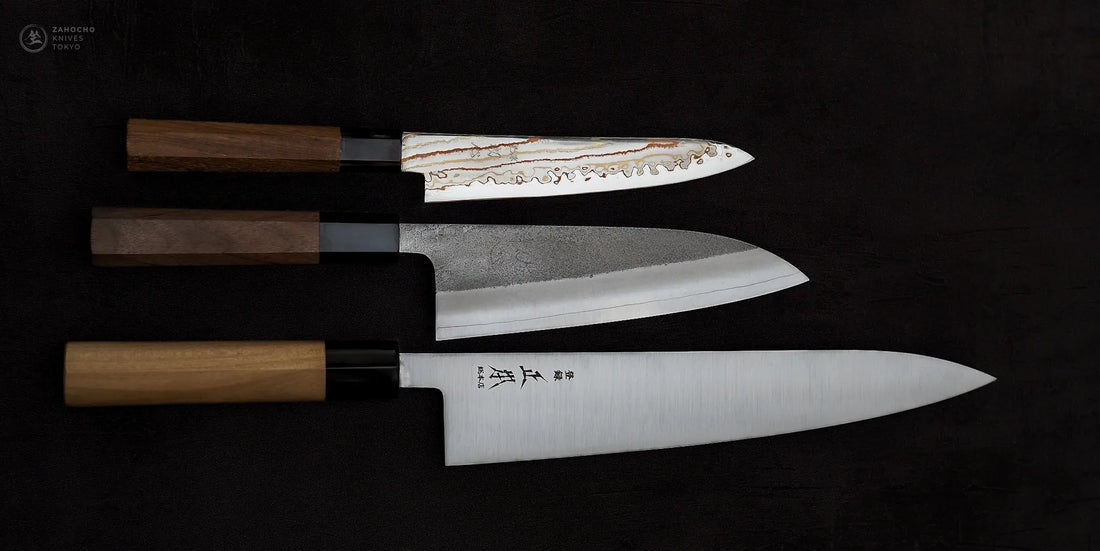Japanese knives have become increasingly popular in recent years, and for good reason. They offer a level of precision and craftsmanship that is unmatched by other types of knives. However, with so many different types of Japanese knives available, it can be difficult to know where to start when choosing your first one. In this article, we'll explore some of the key factors you should consider when choosing your first Japanese knife.
I. Knife Type

(Figure 1: The three Japanese multipurpose knives: santoku, bunka, and gyuto)
When it comes to choosing a Japanese knife, one of the first decisions you'll need to make is whether to go with a gyuto, santoku, or bunka. All three are popular multipurpose knives that can handle a wide range of cutting tasks, but there are some differences between them that may influence your decision.
A gyuto knife is a Japanese version of a Western chef's knife, and is generally considered to be the most versatile type of Japanese knife. It typically has a longer blade (210-270mm/ 8.2-10.6 inches) than a santoku knife or bunka. The blade's length also makes it easier to slice through larger foods like roasts or watermelons. Because of its versatility, a gyuto is a popular choice for both professional chefs and home cooks.
A santoku, on the other hand, is a shorter (165-180mm/ 6.5-7.0 inches), wider knife with a slightly straighter edge than a gyuto. It's often called a "three virtues" knife, as it's designed to excel at three tasks: slicing, chopping, and dicing. Its shorter length can make it easier to maneuver in a smaller kitchen. A santoku is a popular choice for home cooks who value versatility, but may not need the length of a gyuto.
Another option is bunka knife which is basically a santoku with a triangle-shaped tip or a reverse tanto profile which gives it a dexterous and delicate tip. Just like the santoku, it's another popular option if you prefer something short and wide with a slightly flatter profile.
Ultimately, the choice between a gyuto, santoku, or bunka comes down to personal preference. If you're not sure which to choose, a gyuto knife is a safe bet as it's the most versatile of the three.
II. Steel Type: Stainless vs Carbon (vs Stainless-clad Carbon)

(Figure 2: A cross-section of stainless-clad carbon Japanese knife)
Another factor to consider when choosing a Japanese knife is the type of steel used in the blade. Japanese knives are typically made from one of two types of steel: stainless or carbon.
Stainless steel is rust-resistant and easy to maintain, making it a popular choice for home cooks as well as pro chefs. It's also less prone to staining and discoloration, which can be a concern with carbon steel knives. Examples of popular Japanese stainless steels are Aichi AUS8, Aichi AUS10, Takefu VG10, Takefu SG2, and Hitachi Ginsan.
Carbon steel, on the other hand, requires more maintenance, as they are prone to rust if left wet or unclean. Newcomers may find the concept of rusting on knives to be more significant than it actually is. While carbon knives can rust, it's not an instantaneous process. Maintaining a carbon steel knife is not particularly difficult either. With regular cleaning and drying after each use, you can easily prevent rusting. Examples of Japanese carbon steels include White/Shirogami (shirogami#1, #2, #3) and Blue/Aogami steels (aogami super, aogami#1, aogami#2) from Hitachi.
The question of whether carbon or stainless steel is superior is frequently asked in regards to Japanese kitchen knives. However, for those who are new to the world of Japanese knives, it's crucial to avoid overthinking the decision. The main factor to consider is your comfort level with the maintenance involved with carbon steel. If you prioritize convenience and want to avoid rust concerns, then stainless steel may be a more suitable option for you.
In a future blog post, we'll discuss the detailed differences between various Japanese knife steel types. For now, we recommend focusing on the most crucial factor, which is choosing between stainless and carbon steel based on your preferences.
However, for those who want the best of both worlds, stainless-clad carbon steel is an excellent option. This type of steel construction combines the sharpness of carbon steel with the rust and stain resistance of stainless steel. The core of the blade is made from carbon steel, which is sandwiched between two layers of stainless steel to protect the rest of the blade from rust and discoloration.
Note: On our website, one can easily filter Japanese knives by steel type: carbon, stainless, and stainless-clad carbon.

(Figure 3: Filter option for steel type on our website)
III. Aesthetics

(Figure 4: Japanese knife finishes from L-R: migaki, damascus, nashiji, tsuchime, kurouchi)
Aesthetics is also an important factor to consider when selecting a Japanese knife, and it can be particularly exciting for newcomers. The finish of a Japanese knife refers to the surface texture and appearance of its blade. To help you choose the right knife, it's essential to explore the different finishes available. Here are some of the most common Japanese knife finishes to consider:
- Migaki finish: This is a polished finish on Japanese knives that gives them a sleek and elegant appearance. With this finish, the knife has a smooth and matte-like appearance with a slight sheen. It's important to keep in mind that maintaining the appearance of a polished Japanese knife will require extra care and attention. However, knives are meant to be used as tools, so while they are easily scratched, it shouldn't be a major concern.
- Damascus finish: The damascus finish involves layering various types of steel to produce a unique pattern on the blade's surface. It's critical to highlight that the damascus finish is purely for aesthetic purposes and has no impact on the knife's performance and/or sharpness. Claims that damascus makes a Japanese knife sharper are deceptive marketing tactics aimed at first-time buyers. Be cautious of those who make such assertions.
- Nashiji finish: The term "nashiji" in Japanese translates to "pear skin pattern”. This finish gives the blade a distinctive, rustic appearance and a cool, textured feel. It imitates the texture of Asian pear skin by leaving the surface of the blade looking unfinished.
- Tsuchime finish: This finish is achieved by hammering the blade with a special hammer that leaves small dimples on the surface. The tsuchime or hammered finish gives the blade a unique look while also making it less prone to sticking to food.
- Kurouchi finish: This finish is characterized by a black, rustic-looking layer on the blade. This layer is a result of the knife being left unpolished after the blacksmithing process. Kurouchi-finished knives are known for their unique appearance and are often chosen for their rustic charm.
IV. Handle Type

(Figure 5: A yo-gyuto and a wa-gyuto)
The handle of your Japanese knife is another important factor to consider. Japanese knife handles come in two main types: Western and Japanese.
Western-style handles ("yo") are typically larger and heavier, with a curved grip that fits comfortably in the hand. They are often made of materials like plastic, wood, or resin, and can be more durable than Japanese-style handles.
Japanese-style handles ("wa"), on the other hand, are lighter, with a straight, cylindrical grip that fits snugly in the hand. They are often made of wood and are designed to be comfortable and ergonomic for a range of cutting tasks. Handle shapes are usually octagonal, oval, or d-shaped.
As with other factors, the choice between Western and Japanese handles ultimately comes down to personal preference.
V. Price Range
 (Figure 6: An affordable Yoshihiro kurouchi santoku priced at $80, and the highly sought-after Kiyoshi Kato gyuto, a collector's piece, priced at around $1,500.)
(Figure 6: An affordable Yoshihiro kurouchi santoku priced at $80, and the highly sought-after Kiyoshi Kato gyuto, a collector's piece, priced at around $1,500.)
Next, consider your price range when choosing your first Japanese knife. Japanese knives can range in price from under $50 to over $1,000, depending on the quality of the materials used, the level of craftsmanship involved, and the rarity of the piece.
In the realm of high-end Japanese knives, the price is often influenced by factors such as rarity, craftsmanship, reputation, and brand. Rarity plays a significant role, as certain knives may be handcrafted in limited quantities or forged through unique, traditional processes. The lineage and reputation of the craftsman can also impact the price, as knives made by renowned craftsmen or reputable brands often command higher prices.
It's crucial to understand, however, that a higher price, particularly for collector's pieces, does not always equate to better performance. These knives, while beautiful and valuable, may not necessarily outperform less expensive options in a culinary context.
Despite this, it's worth noting that high-quality knives, both in performance and aesthetics, can be found at more affordable price points. When shopping for a Japanese knife, consider how often you'll be using your knife, your budget, and how important the brand or maker's value is to you. If you're a professional chef or someone who cooks frequently and values handcrafted high-performance tools, it may be worth investing in a higher-end Japanese knife. However, if you're a casual cook or just starting out, an affordable mid-range knife may be a better choice.
To cater to different price ranges, we have categorized our knife collections into three categories: Popular Picks Collection, Enthusiast Selection, and Collector's Choice. These categories represent various price ranges, ensuring that you can find a Japanese knife that suits your budget and needs.
If you're not sure where to start, we've compiled a perfect collection for newcomers in the world of Japanese knives: the Popular Picks Collection.
VI. Brand
It's important to keep in mind that while the majority of Japanese knife brands are renowned for their exceptional quality, there are differences in terms of their design, materials used, and price range. Some brands may specialize in traditional knife-making techniques, while others may incorporate modern technologies and innovations. Additionally, certain brands may offer more affordable options to cater to a wider range of customers, while others may cater specifically to high-end markets with their premium products.
Furthermore, each brand has its unique style and aesthetic. Some have sleek and modern designs that appeal to the contemporary user, while others have a rustic, artisanal feel that resonates with those who value traditional craftsmanship.
Although there are various trustworthy Japanese knife brands available, including those we offer, ultimately, your personal preferences will determine the best choice. It's unnecessary to overthink the decision, as all the brands we provide are exceptional options. Follow your instincts and choose the one that resonates with you the most. If you require assistance or suggestions, don't hesitate to reach out to us for support.
Conclusion
Selecting the right Japanese knife can seem daunting at first, but considering factors such as knife type, steel type, finish, handle type, and price range can help you find a knife that fits your needs and preferences. Whether you choose a versatile gyuto or a nimble santoku, a rust-resistant stainless steel blade, and a comfortable Western or Japanese-style handle, a high-quality Japanese knife can greatly improve your cooking experience. If you have any questions or need further advice, please feel free to contact us.

